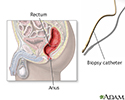Rectal biopsy
Biopsy - rectum; Rectal bleeding - biopsy; Rectal polyps - biopsy; Amyloidosis - rectal biopsy; Crohn disease - rectal biopsy; Colorectal cancer - biopsy; Hirschsprung disease - rectal biopsy
A rectal biopsy is a procedure to remove a small piece of tissue from the rectum for examination.
How the Test is Performed
A rectal biopsy is usually part of anoscopy or sigmoidoscopy. These are procedures to view inside the rectum.
A digital rectal exam is done first. Then, a lubricated instrument (anoscope or proctoscope) is placed into the rectum. You will feel some discomfort when this is done.
A biopsy can be taken through any of these instruments.
How to Prepare for the Test
You may get a laxative, enema, or other preparation before the biopsy so that you can completely empty your bowel. This will allow the health care provider a clear view of the rectum.
How the Test will Feel
There will be some discomfort during the procedure. You may feel like you need to have a bowel movement. You may feel cramping or mild discomfort as the instrument is placed into the rectal area. You may feel a pinch when a biopsy is taken.
Why the Test is Performed
A rectal biopsy is used to determine the cause of abnormal growths found during anoscopy, sigmoidoscopy, or other tests. It can also be used to confirm the diagnosis of amyloidosis (rare disorder in which abnormal proteins build up in tissues and organs).
Normal Results
The anus and rectum appear normal in size, color, and shape. There should be no evidence of:
- Bleeding
- Polyps (growth on the lining of the anus)
- Hemorrhoids (swollen veins in the anus or lower part of the rectum)
- Other abnormalities
No problems are seen when the biopsy tissue is examined under a microscope.
What Abnormal Results Mean
This test is a common way to determine the specific causes of abnormal conditions of the rectum, such as:
- Abscesses (collection of pus in the area of the anus and rectum)
- Colorectal polyps
- Infection
- Inflammation
- Tumors
- Amyloidosis
- Crohn disease (inflammation of the digestive tract)
- Hirschsprung disease in infants (blockage of the large intestine)
- Ulcerative colitis (inflammation of the lining of the large intestine and rectum)
Risks
Risks of a rectal biopsy include bleeding.
References
Downs JM, Kulow B. Anal diseases. In: Feldman M, Friedman LS, Brandt LJ, eds. Sleisenger and Fordtran's Gastrointestinal and Liver Disease. 11th ed. Philadelphia, PA: Elsevier; 2021:chap 129.
Gibson JA, Odze RD. Tissue sampling, specimen handling, and laboratory processing. In: Chandrasekhara V, Elmunzer J, Khashab MA, Muthusamy VR, eds. Clinical Gastrointestinal Endoscopy. 3rd ed. Philadelphia, PA: Elsevier; 2019:chap 5.
Review Date: 8/22/2022
Reviewed By: Debra G. Wechter, MD, FACS, General Surgery Practice Specializing in Breast Cancer, Virginia Mason Medical Center, Seattle, WA. Also reviewed by David C. Dugdale, MD, Medical Director, Brenda Conaway, Editorial Director, and the A.D.A.M. Editorial team.









